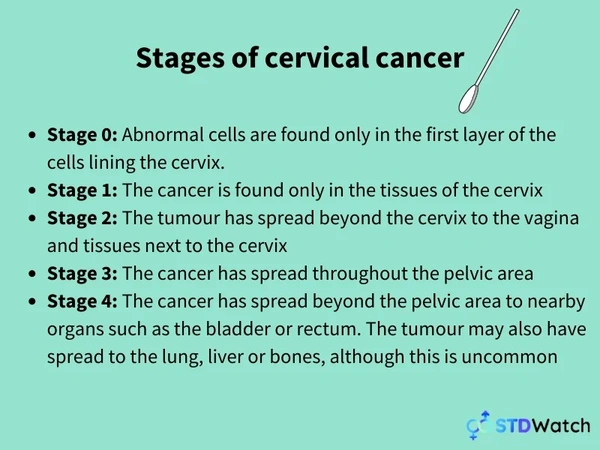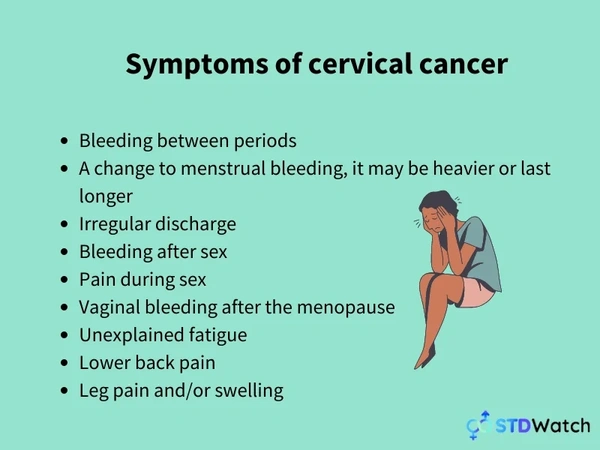Cancer, as defined by the Centers for Disease Control and Prevention is a disease in which cells in the body grow out of control.
Cancer is always named for the part of the body where it starts, even if it spreads to other body parts later.
Cervical cancer describes a cancer which affects the cervix. The cervix connects the vagina (birth canal) to the upper part of the uterus.
In this article, we will talk you through cervical cancer stages, symptoms, prognosis as well as screening recommendations as they relate to cervical cancer.
Cervical cancer stages
Cervical cancer used to be the leading cause of cancer death for women in the United States. However, in the past 40 years, the number of cases of cervical cancer and the number of deaths from cervical cancer have decreased significantly. This decline largely is the result of many women getting regular Pap tests, which can find cervical precancer before it turns into cancer.
Read: Do pap smears hurt? Plus other common FAQs
Cervical cancer stages have been developed by the Cancer Council, they are as follows:
- Stage 0: Abnormal cells are found only in the first layer of the cells lining the cervix.
- Stage 1: The cancer is found only in the tissues of the cervix
- Stage 2: The tumour has spread beyond the cervix to the vagina and tissues next to the cervix
- Stage 3: The cancer has spread throughout the pelvic area
- Stage 4: The cancer has spread beyond the pelvic area to nearby organs such as the bladder or rectum. The tumour may also have spread to the lung, liver or bones, although this is uncommon
Cervical cancer symptoms
It is rare to experience cervical cancer symptoms in the early stages. If symptoms do occur in the later stages, they may include:
- Bleeding between periods
- A change to menstrual bleeding, it may be heavier or last longer
- Irregular discharge
- Bleeding after sex
- Pain during sex
- Vaginal bleeding after the menopause
- Unexplained fatigue
- Lower back pain
- Leg pain and/or swelling
How long do you have to live if you have cervical cancer?
Each experience of cervical cancer will be different for each unique person, therefore it is almost impossible to predict a prognosis when speaking generally.
Prevention truly is the best cure. meaning that the earlier cervical cancer is diagnosed, the better the prognosis (outcome.)
Can you survive stage three of cervical cancer?
There is no one size fits all approach when it comes to cervical cancer. You may wish to discuss your prognosis and treatment options with your doctor, but it’s not possible for any doctor to predict the exact course of your cancer. Test results, the type of cancer you have, the rate and depth of tumour growth, how well you respond to treatment, and other factors such as age, fitness and medical history are all important in assessing your prognosis.
How do you get tested for cervical cancer?
Screening recommendations, according to the National Cancer Institute for cervical cancer in the United States are as follows:
ACS recommends cervical cancer screening with an HPV test alone every 5 years for everyone with a cervix from age 25 until age 65. If HPV testing alone is not available, people can get screened with an HPV/Pap co-test every 5 years or a Pap test every 3 years.
A Pap test, often called a Pap smear, looks for abnormal cells that can lead to cancer in the cervix. An HPV test looks for the human papillomavirus, a virus that can cause cervical cancer. For an HPV/Pap co-test, an HPV test and a Pap test are done together.
For a patient at the doctor’s office, an HPV test and a Pap test are done the same way—by collecting a sample of cervical cells with a scraper or brush.
The Pap test has been the mainstay of cervical cancer screening for decades. HPV tests are a newer method of cervical cancer screening. Two HPV tests have been approved by the Food and Drug Administration (FDA) for use as a primary HPV test, meaning it is not part of an HPV/Pap co-test. Other HPV tests are approved as part of an HPV/Pap co-test.
- Read: What causes abnormal Pap smears besides HPV?
- Read: Skin tag vs. HPV: What’s the difference?
- Read: Does HPV go away?
References
- Basic Information About Cervical Cancer - cdc.gov
- Do pap smears hurt? Plus other common FAQs - stdwatch.com
- Cervical cancer - cancerwa.asn.au
- What causes abnormal Pap smears besides HPV? - stdwatch.com
- Skin tag vs. HPV: What’s the difference? - stdwatch.com
- Does HPV go away? - stdwatch.com


